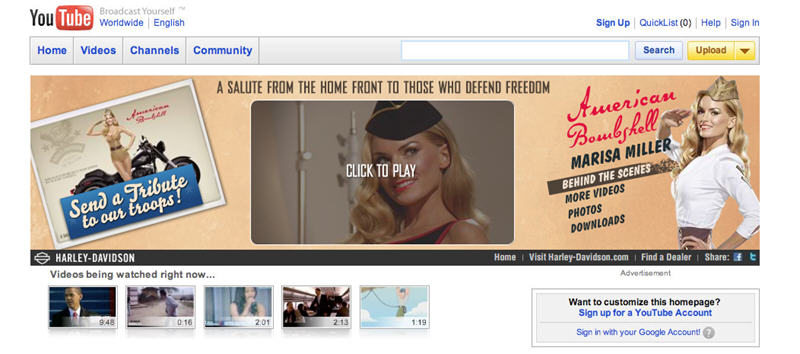Online display advertising – with the help of mobile and augmented reality – has the ability to overtake TV as the most creative advertising media, internet giant Google has forecast, unveiling a future of limitless advertising.
“There’s no doubt that advertisers today are increasingly seeking to run campaigns that are highly measurable and relevant to users,” said Neal Mohan, vice-president of product management at Google. “That’s one of the benefits of advertising on the internet.
“But great ad campaigns are about more than clicks or numbers. The best campaigns are so memorable and effective because they make an emotional bond with us. The very best can engage us, move us and make us feel a connection with the brand that’s being promoted. That’s the real creative genius of advertising.
“We traditionally think of TV as the most creative advertising media. But display advertising has the promise of a couple of things that even TV doesn’t have — the ability to dynamically customise ads in infinite ways and the opportunity to enable a true two-way interaction and dialogue with users,” he said.
Mohan gave the example of an ad campaign for a coffee chain in Denver that on a warm afternoon runs a display campaign offering Denverites a coupon for an ice cold latte with a searchable map embedded, directing them to outlets and real-time tweets from people who’ve already imbibed. The same evening, a cold front rolls over the Rockies and the campaign switches to promoting hot chocolate.

“Creative? Absolutely. Impossible? Hardly. You can do this today using technology from Teracent that we’re working to roll out for our clients who advertise on the Google Content Network or who use DoubleClick Rich Media.”
Mohan gave other examples, such as an award-winning rich media ad that was created by Euro RSCG for the new Volvo XC60. In addition to an interactive game, photos and gallery, it incorporated a Twitter feed from the New York Auto Show. In just three days, the campaign garnered 170 million impressions, 50,000 clicks and 17,000 hours of brand engagement. No other type of advertising format could have come close in driving this type of conversation with a brand’s potential customers.
An ad that works like a website
He also gave the example of a campaign for Harley Davidson, created by the agency Overdrive. The ad functions almost like a website — with interactive video, Twitter and Facebook Share functionality, as it invites people to send a “Tribute to the Troops” for Veteran’s Day. More than 280,000 people clicked to watch the video embedded in the ads and more than 18,000 tributes were sent to troops from this campaign.
“Some in our industry have asked why we aren’t seeing more creative display ad campaigns like these. In our view, it’s definitely not because of a lack of creativity or an unwillingness to experiment. The problem to date has been the lack of tools and technologies necessary to do this at scale across the Internet.
“It takes hard work to create, serve and measure the impact of these ads. Under the hood, there’s a lot of technology that needs to come together for them to work seamlessly. Take the Harley Davidson ad: It contains dozens of complex creative elements, integrations with various technologies like Flash, numerous APIs, Twitter and Facebook, and multiple parties involved in its creation and delivery — from the creative agency, to teams at Google, through to the ad operations teams at the publisher.
“You could spend hundreds or thousands of hours building out creative concepts and ads like this, but ultimately only run them on a few sites because the customisation takes so much time to implement across the web.
“We believe that technology, by streamlining and eliminating some of the hard work involved, and by offering new creative possibilities, can be a great enabler of more creative ads.
“What if it were seamless to serve and run highly creative ad units — not just on one site, but on thousands of sites, and also in videos and on mobile phones? What if it were simpler to incorporate social features in the ad creative itself — such as letting people endorse and spread particular ads or campaigns to their friends? What if you could serve video ads that included simple tools in the ad creative itself that allowed users to easily make their own mashups of your ad, and post and share them with friends?”
Benefit of technology’s rapid evolution
Mohan said technology is evolving rapidly and will help facilitate all of this in the months and years ahead.
“What about imagining what might be possible on your phone in a few years? Let’s say you’re walking down the street, using an augmented reality app on your mobile phone to see what’s interesting around you. In your viewfinder, you see a billboard for a great product — basketball shoes.
“Using image recognition, the app could recognise that it’s a billboard for a particular shoe brand, show an expandable ad for that brand, let you choose to watch a video of one of their shoes in action, display all the nearest stores on an accompanying map, and include a way for you to order a shoe and pick it up on your way home from work.
That’s just one example of what one day will be possible in the world of display advertising. It’s the goal of our display advertising efforts to produce the tools and technologies to allow for this type of unbridled creativity at a grand scale,” Mohan said.
By John Kennedy